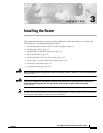
2-10
Cisco 3600 Series Routers Hardware Installation Guide
OL-2056-05
Chapter 2 Preparing to Install the Router
Preparing to Connect to a Network
Preparing to Connect to a Network
When setting up your router, consider distance limitations and potential electromagnetic interference
(EMI) as defined by the applicable local and international regulations.
Network connection considerations are provided for several types of network interfaces and are
described in the following sections:
• Ethernet Connections, page 2-10
• Token Ring Connections, page 2-11
• Serial Connections, page 2-11
• ISDN BRI Connections, page 2-13
• 56-K/Switched-56-kbps DSU/CSU Connections, page 2-14
Refer to the following online documents for more information about network connections and interfaces:
• Cisco Network Modules Hardware Installation Guide
• Cisco Interface Cards Installation Guide
• Cisco Modular Access Router Cable Specifications
Warning
To avoid electric shock, do not connect safety extra-low voltage (SELV) circuits to telephone-network
voltage (TNV) circuits. LAN ports contain SELV circuits, and WAN ports contain TNV circuits. Some
LAN and WAN ports both use RJ-45 connectors.
Statement 1021
Ethernet Connections
The IEEE has established Ethernet as standard IEEE 802.3. The most common Ethernet implementations
are as follows:
• 100BASE-T—2-pair Category 5 or unshielded twisted-pair (UTP) straight-through RJ-45 cable.
• 10BASE-2—Ethernet on thin coaxial cable, also known as thin Ethernet. The maximum segment
distance is 607 feet (186 meters).
• 10BASE-5—Ethernet on thick coaxial cable, also known as thick Ethernet. The maximum segment
distance is 1,640 feet (500 meters).
• 10BASE-T—Ethernet on unshielded twisted-pair (UTP) cable. The maximum segment distance is
328 feet (100 meters). UTP cables look like the wiring used for ordinary telephones; however, UTP
cables meet certain electrical standards that telephone cables do not meet.
Refer to the Cisco Modular Access Router Cable Specifications online document for information about
Ethernet cables, connectors, and pinouts. This document is available online and on the Cisco
Documentation CD-ROM.


















